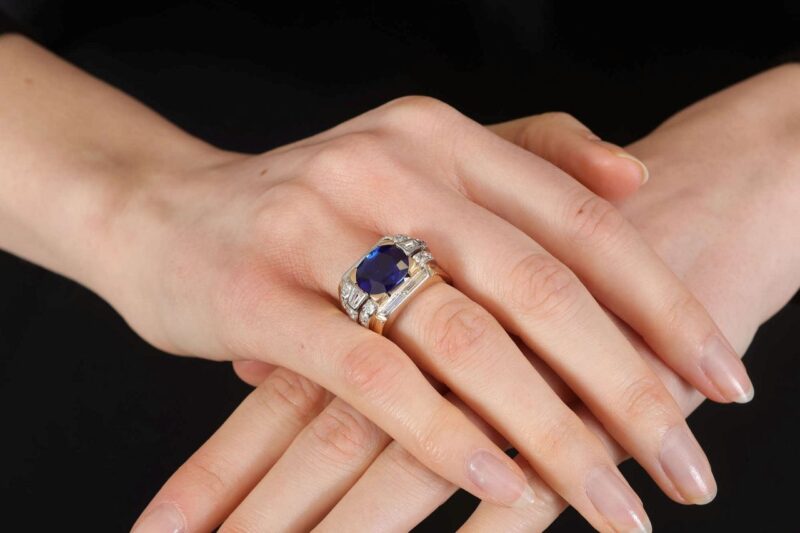A sapphire and diamond ring containing a newly identified Kashmir sapphire is due to be auctioned by Adam’s of Dublin on 13 May 2025, as part of its Fine Jewellery and Ladies’ Watches sale.
The 6.22 carat stone, previously thought to be of unknown origin, has been certified as a Kashmir sapphire by two gemmological laboratories.
Identification and Reappraisal
The ring, catalogued as Lot 23, is described as “of tank design, centring a cushion-shaped sapphire weighing 6.22cts, between old brilliant and tapered baguette-cut diamond shoulders, and between baguette-cut diamond borders.” The piece dates to the 1940s and was originally valued between €8,000 and €12,000. Following testing and identification of its Kashmir origin, the auction estimate has been raised to €150,000–€250,000.
Claire-Laurence Mestrallet, Head of Jewellery at Adam’s, noted: “Kashmir sapphires have an intense blue colour and a velvety appearance. It’s unusual to find one in a 1940s ring.” She added, “I think this is the first time a Kashmir sapphire has been auctioned in Ireland.”
Verification by International Laboratories
The stone was removed from its setting and examined by Gemmological Certification Services (GCS) in London. It was confirmed as “of Kashmir origin, with no indications of heating.” A second assessment by the Swiss Gemmological Institute (SSEF) supported the same conclusion.
“Kashmir sapphires have an intense blue colour and a velvety appearance,” said Mestrallet. “It’s unusual to find one in a 1940s ring.”
The absence of heat treatment is notable, as many sapphires are routinely heated to improve colour and clarity. This sapphire is natural and untreated.
Background and Rarity
Kashmir sapphires were mined only briefly, between 1882 and 1887, in the Zanskar range of the Himalayas. The origin was reportedly discovered after “a landslip had laid bare the rocks beneath the soil, and disclosed the presence of the gems,” according to Tom D LaTouche, deputy superintendent of the Geological Survey of India in 1890.
LaTouche recounted: “He [a shikari] picked up a small sapphire, and finding that it answered his purpose better than the ordinary fragments of quartz he was in the habit of using, carried it about with him for some time.” The hunter eventually sold the stone to a trader, “from whom it was taken to Simla, where its value was recognised.”
Efforts were soon made to protect the site and control the flow of sapphires into the market. LaTouche wrote that guards were posted because “the Laholis only asking about one rupee per seer for them.”
Though the mine has been closed for more than a century, Kashmir sapphires continue to command premium prices at auction. On 25 April, an 11.56 carat Kashmir sapphire and diamond ring sold at Sotheby’s Hong Kong for HKD $6,350,000 (€721,514).
“The mine was only open for five years,” Mestrallet explained. “Then it closed. It’s been closed for more than 100 years.”
Gemmological Challenges and Market Implications
Identifying the source of a sapphire is a complex process. As noted in Gems & Gemology (2019), sapphire sourcing was once limited to Kashmir, Myanmar, and Sri Lanka. However, newer sources such as Madagascar, which began producing significant volumes around 25 years ago, have increased the need for advanced origin testing.
“A fine, classical Kashmir sapphire can be sold for many times more than a Madagascar sapphire of exceptional quality and size,” according to industry sources.
Identification is based on internal features, such as mineral inclusions and “patterns of silk and particle clouds.” These are often described in poetic terms. “These milky bands are the cause of the sleepy, velvety texture so admired in fine Kashmir sapphires.”
Auction Details:
- Auction House: Adam’s, Dublin
- Date: 13 May 2025
- Lot: 23
- Estimate: €150,000–€250,000
- Stone: 6.22ct cushion-shaped unheated Kashmir sapphire
- Mounting: 1940s ring with diamond shoulders and borders
- Certification: GCS (London) and SSEF (Switzerland)
Industry Significance
For the trade, the reappearance of a Kashmir sapphire from a private French collection demonstrates the ongoing importance of gemmological certification in provenance determination and valuation. The sale also highlights the role of auction houses in bringing such stones to market.
The upcoming auction at Adam’s may mark the first time a Kashmir sapphire has been offered publicly in Ireland.




